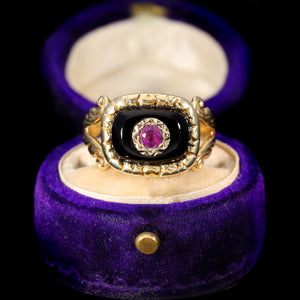Mourning Jewellery: The Symbols Behind the Stones
Mourning jewellery holds a unique place in the history of adornment—intimately personal, deeply symbolic, and often beautifully crafted. These pieces were not merely fashion statements; they were worn as quiet tributes to loved ones lost, carrying with them coded messages of grief, remembrance, and affection. In antique rings especially, the materials and motifs chosen were rich with meaning. From pearls representing tears to white enamel symbolising innocence, every element had significance.
The Rise of Mourning Jewellery
While mourning jewellery dates back centuries, it flourished during the 18th and 19th centuries, particularly in the Georgian and Victorian eras. Queen Victoria’s extended mourning for Prince Albert influenced generations, and black attire paired with jet and enamel jewellery became widely popular. Mourning rings were often commissioned to honour family members or close friends, combining sentimental design with wearable remembrance.
Symbolic Materials and Their Meanings
Pearls: Often used to symbolise tears, pearls were a delicate and poignant choice in mourning rings—especially for mothers mourning children. Their soft lustre evoked a sense of quiet sorrow and emotional depth.
White Enamel: White enamel was traditionally used in mourning pieces for children or unmarried women, representing purity and innocence. It’s frequently seen in Georgian mourning rings, highlighting the youth or virtue of the departed.
Black Enamel: The most commonly associated material with mourning jewellery, black enamel conveyed grief and solemnity. Used in combination with gold, it created striking designs that balanced elegance with sorrow.
Jet and Onyx: Deep black stones like jet (particularly Whitby jet) and onyx were often used in Victorian mourning rings. Jet was lightweight and easily carved, while onyx offered a glossy, reflective surface—both evoking quiet mourning.
Hairwork: Though not a stone, woven or enclosed locks of hair were frequently integrated into mourning jewellery. Set behind glass or within a compartment, they offered a physical connection to the deceased.
Motifs and Messaging
Mourning rings frequently featured symbols like urns, willows, and clasped hands. These motifs, alongside the choice of gemstone or enamel, helped personalise the piece. Engravings were common, often including initials, dates, or short inscriptions such as “In Memory Of.”
Mourning Rings in Antique Jewellery
Today, antique mourning rings are cherished for their beauty, history, and emotional resonance. Whether featuring pearls, enamel, or finely worked gold, these pieces speak to a bygone era of personal tribute through jewellery. Explore our curated collection of antique rings to discover mourning rings that offer not only historic value but a profound sense of sentiment and symbolism.


